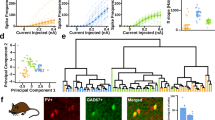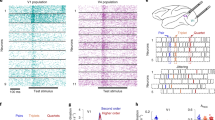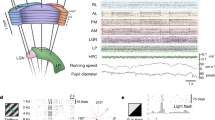Abstract
OUR understanding of information processing in nerve nets has been modified by the concept of graded signal transmission1. Descriptions of non-spiking interneurones in insects2–8, and the demonstration of graded synaptic transmission3 have contributed to this development. In the fly visual nervous system, second and higher order interneurones are known, which apparently do not produce action potentials6–8. We show here that at least eight individually identifiable movement-sensitive cells, which have the characteristic properties of non-spiking interneurones2 will generate spikes with imposed hyperpolarisation. Their graded mode of operation is due to maintained refractoriness. This applies selectively to neurones, which belong to either of two anatomically, and physiologically distinct classes. Other cell types in the same preparation generate spikes spontaneously.
This is a preview of subscription content, access via your institution
Access options
Subscribe to this journal
Receive 51 print issues and online access
$199.00 per year
only $3.90 per issue
Buy this article
- Purchase on Springer Link
- Instant access to full article PDF
Prices may be subject to local taxes which are calculated during checkout
Similar content being viewed by others
References
Schmitt, F. O., Dev, P. & Smith, B. H. Science 193, 114–120 (1976).
Pearson, K. G. & Fuortner, C. R. J. Neurophysiol. 38, 33–52 (1975).
Burrows, M. & Siegler, M. V. S. Nature 262, 222–224 (1976).
Chappell, R. L. & Dowling, J. E. J. gen. Physiol. 60, 121–147 (1972).
Laughlin, S. B. J. comp. Physiol. 112, 199–212 (1976).
Zettler, F. & Järvilehto, M. J. comp. Physiol. 85, 89–104 (1973).
Dvorak, D. R., Bishop, L. G. & Eckert, H. E. J. comp. Physiol. 100, 5–23 (1975).
Hausen, K. Z. Naturforsch 31c, 629–633 (1976); thesis, Univ. Tübingen (1976).
Pierantoni, R. Cell. Tiss. Res. 171, 101–122 (1976).
Strausfeld, N. J. Atlas of an Insect Brain, Table 7.29 (Springer, Heidelberg 1976).
Götz, K. G. Kybernetik 2, 77–92 (1964); 4, 199–208 (1968).
Götz, K. G. & Wenking, H. J. comp. Physiol. 85, 235–266 (1973).
Reichardt, W. & Poggio, T. Q. Rev. Biophys. 9, 311–438 (1976).
Barlow, R. B. & Kaplan, E. J. gen. Physiol. 69, 203–220 (1977).
Author information
Authors and Affiliations
Rights and permissions
About this article
Cite this article
HENGSTENBERG, R. Spike responses of ‘non-spiking’ visual interneurone. Nature 270, 338–340 (1977). https://doi.org/10.1038/270338a0
Received:
Accepted:
Issue Date:
DOI: https://doi.org/10.1038/270338a0
This article is cited by
-
Subcellular mapping of dendritic activity in optic flow processing neurons
Journal of Comparative Physiology A (2014)
-
Localized direction selective responses in the dendrites of visual interneurons of the fly
BMC Biology (2010)
-
Active flight increases the gain of visual motion processing in Drosophila
Nature Neuroscience (2010)
-
Amplification of high-frequency synaptic inputs by active dendritic membrane processes
Nature (1996)
-
Integrative properties of second-order visual neurons: a study of large monopolar cells in the droneflyEristalis
Journal of Comparative Physiology A (1988)
Comments
By submitting a comment you agree to abide by our Terms and Community Guidelines. If you find something abusive or that does not comply with our terms or guidelines please flag it as inappropriate.



